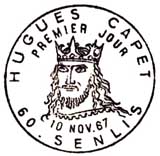TIMBRES DE FRANCE
Ex : 50 c
Ex : 456
Ex : Appel du 18 juin
Ex : 1900
Ex : Femme
mini 4 lettres
Création du site : Juillet 2005
Nombre de visiteurs : 34.188.702
Nombre de pages : 112.791.519
Dernière mise à jour 26-03-2025
Nombre de visiteurs : 34.188.702
Nombre de pages : 112.791.519
Dernière mise à jour 26-03-2025
Cette bannière est une publicité le site n'a aucune boutique de vente
Les informations sur ce timbre ont été mises à jour le : 24/10/2024

Hugues Capet (938-996)
Timbre : Courant / moderne
Voir tous les timbres courants de l'année 1967
Listage des timbres de l'année 1967



Cachet premier jour


Premier jour : Oblitération 1er jour à Paris le 10 novembre 1967
Vente générale : 13 novembre 1967
Retrait de la vente : 19 octobre 1968
Valeur faciale : 40 c
Graveur : Albert Decaris
Dessinateur : Albert Decaris
Département concerné par ce timbre : Essonne
Dentelure : Dentelé 13
Couleur : bleu vert foncé et outremer
Mode d'impression : Taille douce
Format du timbre : 52 x 31 mm (image 48x27 mm bords externes des filets)
Quantité émis : 7.212.000
Présentation : Feuille de 25 timbres
Bande phosphore : Sans
Catalogue Yvert et Tellier France : N° 1537
Catalogue Spink / Maury France : N° 1537
Catalogue Michel : N° FR 1605
Catalogue Scott : N° FR 1200
Valeur marchande timbre neuf avec gomme intacte: 0,10 €
Valeur marchande timbre oblitéré : 0,09 €
La valeur marchande représente une valeur de base du timbre pour la vente ou l'échange
Thématique catégorie : Batailles, tratés, rois, reine, personnages
Informations sur le sujet du timbre
Hugues Capet
né vers 939-941 probablement à Dourdan, mort le 24 octobre 996 probablement au lieu-dit « le Juif » dépendant de l'abbaye de Saint-Martin de Tours., près de Prasville, duc des Francs (960-987), puis roi des Francs (987-996), fut le premier souverain de la dynastie capétienne.Il accède à la royauté, après la mort de Louis V, quand l'assemblée des grands du royaume, réunie à Noyon, le 1er juin 987, le choisit contre son rival Charles de Basse-Lorraine, le « prétendant » des Carolingiens. Un mois plus tard, il est sacré par l'archevêque de Reims, Adalbéron. Le premier Capétien semble, d'après les...lire la suite
Hugues Capet
born around 939-941 probably in Dourdan, died on 24 October 996 probably in the place called «the Jew» dependent of the abbey of Saint-Martin de Tours., near Prasville, duke of the Francs (960-987), then king of the Franks (987-996), was the first ruler of the Capetian dynasty.He acceded to the kingship after the death of Louis V, when the assembly of the great rulers of the kingdom, meeting at Noyon on 1 June 987, chose him against his rival Charles of Lower Lorraine, the «pretender» of the Carolingians. A month later, it is consecrated by the archbishop of Reims, Adalbéron. The first Capetian seems, according to the testimonies of his contemporaries, to be of a vigorous physique, quick-witted, even cunning, of a great familiarity with his subjects of which he is loved , very pious one has nicknamed him the «king-priest», he is respectful but firm towards the Church and the clergy who contributed to his advent. His wife, the intelligent and diplomatic Queen Adelaide, seems to have helped him with her wise advice.
Hugues Capet’s power is however weak against the surrounding lords, who flout his authority, and especially in comparison to the powerful counts of Toulouse, Flanders, Anjou or the duke of Normandy. Hugues Capet had the merit of having passed the crown to his son: on the pretext of an attack by the Muslims against the count of Barcelona, who had called for his help, and alleging the risk of his death, he elected and crowned, as early as 987, his eldest son, Robert.
Source : various Internet documents including Wikipedia
Cette page a été visitée 14 312 925 fois depuis le 1er mai 2022
